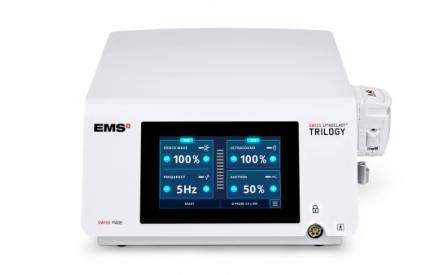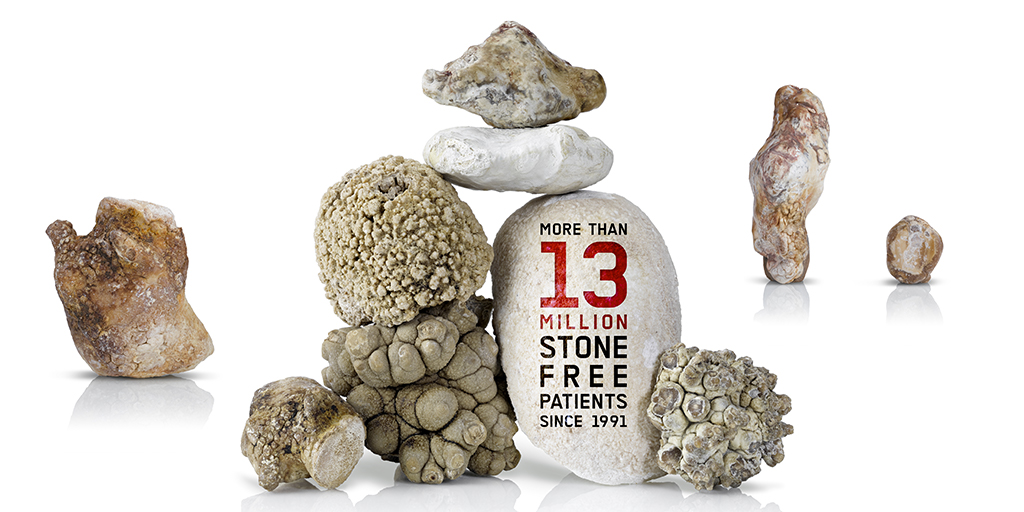
More than 13 million stone-free patients in the last 30 years
Here at EMS, we are proud to say that over the past 30 years we’ve been able to help over 13 million patients to become stone-free and regain their quality of life.
Since the start of our endeavours in the field of Urology, our efforts and philosophy have remained unchanged to provide innovative and effective solutions for the removal of urinary stones in the most efficient, fast and safest way. And topping it all off, are the fundamental principles of precision and quality that our founder, Mr. Bernd Bühner, has held dear, at the company’s core, from EMS’ very first day on the block.
We would like to take this anniversary as an opportunity to do a recap of our history and to also express our thanks to all of our partners, friends and contributors for their continuous support over this unforgettable time span of 30 years.
1991: EMS set out to revolutionize stone removal
The company EMS - Electro Medical Systems was founded 1981 and within 10 years’ time has built an internationally renowned reputation for its impeccable and exemplary manufacturing of dental devices.
Being known as an innovation-oriented company, EMS was approached by Professor Favre, a physicist, and Professor Von Niederhäusern, a urologist at the University of Lausanne, both of whom were responsible for having just developed a first type of urological lithotripter which they unveiled as being completely disruptive and revolutionary to industry norms at the time. Placing his trust in both experts, Mr. Bühner gave the green light, leading to this remarkable and memorable success story.
Andrew Jones, Global Head of the Medical division says, "Here at EMS we are proud to serve our Urology customers with innovation, Swiss precision and class leading education. During these past thirty years we have continued our culture of constant improvement and we see this continuing for many years to come."
Read further to know how it all happened.

EMS Urology
Pioneering Phase
Whereas other companies had before considered the risks too great and the outcome too little or unprofitable, the management here at EMS believed that the field of urology was in dire need of revival. At the time, the existing technologies such as electrohydraulic lithotripsy were either worryingly dangerous or incredibly expensive, also including the early laser systems. The promise of the University of Lausanne to make use of small-calibre probes to disintegrate stones was therefore extremely appealing: a lithotripter that could fragment all types of stones efficiently, safely and cost-effectively.

This was a real revolution at the time. This was the first time that compression waves had been made to travel in small endourology probes with the aim of disintegrating calculus. The simplicity behind this idea was surprising and unexpected: Use it like a Jackhammer.
Therefore, the EMS founder created a small team of two people to spread the use of their new product. They set up a small office on Lake Constance, Germany, were they now worked to promote the novel technology, develop scientific publications and future assets of the Swiss LithoClast®. These are still the key pillars of EMS Urology: Innovation, Scientific Proof and Client Orientation.
What are your first memories with the Swiss LithoClast®? Let us know on Twitter!
Tweet #LithoClast
Sceptics did not fail to criticize this simplicity of the device, and even experts shied away from using something so simple to break urinary stones. But the first results proved that the system proposed by the University of Lausanne was very well balanced for the transmission of impulses. Suddenly, very thin probes could be used to disintegrate even the hardest of stones. This new technology was so powerful that it led to the demise of diode and alexandrite lasers, which had been the standard in the hospitals that could afford them.
In 1991, EMS introduced the Swiss LithoClast® at the World Congress of Endourology in Vienna. Although the curiosity was obvious, there still was quite some reluctance and scepticism about this new technology from endourologists.

Swiss LithoClast®
Adoption phase
Within two years, Swiss LithoClast® became a worldwide success. This is largely thanks to the support of 10 influential professors at various European universities, such as Professor Senge in Germany or Professor Marberger in Austria. These influential professors quickly published numerous scientific studies on LithoClast®, further supporting the effectiveness and capability of the new product. More than 20 studies were finally presented at the World Congress of Endourology in Singapore in 1994, solidifying the success of Swiss LithoClast® and attracting the interest of the world's leading urologists.
At the same time, research within EMS itself had to be stepped up, in order to be able to market Swiss LithoClast® in the most commercially relevant markets of the world: The United States, Japan and Europe; the so called "triad" markets. The first research and development team was formed in-house with the support of five research sites worldwide, being commissioned by Mr. Bühner on behalf of EMS to produce a study for the certification of Swiss LithoClast® by the FDA in the USA.
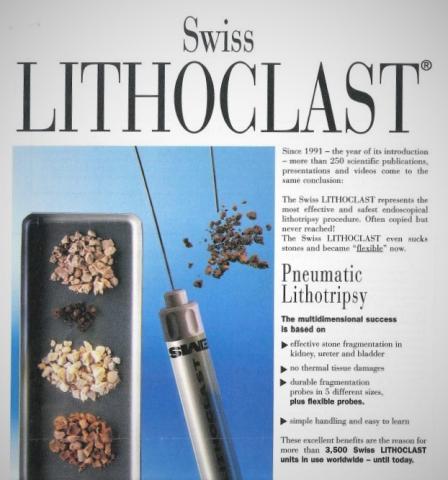
Would you like to learn about one of the first cases treated with the Swiss LithoClast®?
"Parallel lie lower pole stone PCNL" is one of the first case studies which was realized with the LithoClast® by the Professor David Webb at the Austin Health Clinic in Melbourne, Australia.
Fluoroscopy of stone clearance with Swiss LithoClast® and nephrostomy tube placement:
Given the novel nature of the technology, the clinical effort in these early phases proved to be substantial. Most notably, the measurement tools needed to specifically characterise shock waves had first, and yet and to be designed. To start this venture, the EMS teams partnered with the Max Planck Institute in Göttingen, which specialised in fluid dynamics. This, at the time was one of the few places to have created and owned a technology capable of taking high-speed photographs for measurement purposes. By using this unique technology, EMS was able to characterize the movement of the tip of the probe, created by the shock waves. It was now possible to calculate the energy based on probe tip dynamic movement analysis.
By then, the EMS Urology team comprised only six people, but this would be no hindrance in it holding ambitious plans to further develop this innovative technology.
Subsequently, market approvals in the USA, Japan and of course Europe came through and the Swiss LithoClast® rose to huge success worldwide, appreciated for its high quality, efficiency and robustness. Finally, in 1997, Swiss LithoClast® became the first choice for lithotripsy.

The Swiss LithoClast® Master
The Mission: Fast Treatment - Stone-Free Patients
Stone-free post-operative treatment outcome gained increasing importance in urological stone management, requiring simultaneous fragmentation and suction of urinary stones. In the past, ultrasonic lithotripters met this requirement. However, ultrasonic lithotripster limited effectiveness on harder stones, which was prolonging treatment times. Some leading urologists in these days were using the original Swiss LithoClast® to pre-fragment the stones before applying an ultrasound technology to fully ensure fragmentation. This led to the unique and novel idea of combining an ultrasound energy source with a pneumatic impact for simultaneous combination lithotripsy. The pneumatic LithoClast® probe was inserted coaxially into the ultrasonic probe - the dual probe simultaneous lithotripsy design.
The team had meanwhile grown to an increased number, of around 35.
#EMSmasterclass Endoscopic Stone removal Workshop led by @drjanakddesai ? few very interesting cases
— EMS Urology (@EMSUrology) June 25, 2018
One patient presented stones in lower/middle chelices cleared within less than 10 min with the #lithoclastmaster setting of US - 80% pic.twitter.com/bWfjpY30t0
#EMSmasterclass just started today in Turin, led by @scoffonecesare pic.twitter.com/qiOdl84PJV
— EMS Urology (@EMSUrology) May 30, 2018

Swiss LithoClast® Trilogy
Experience lithotripsy like never before
After 18 years of great success of the Swiss LithoClast® Master, a revolutionary new approach to combination lithotripsy was introduced: the Swiss LithoClast® Trilogy.
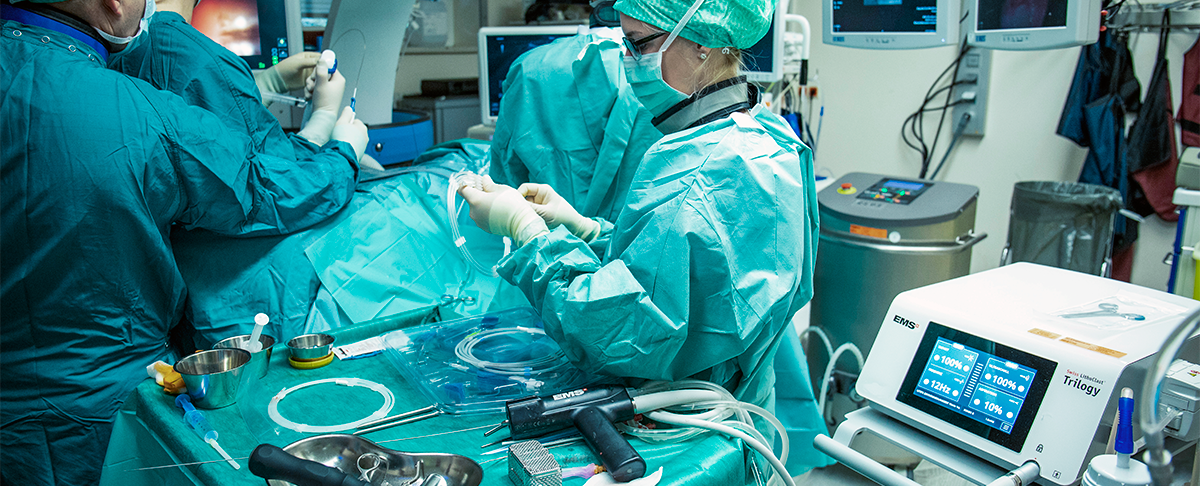
The technical challenge for this new generation of Lithotripter was to transmit ultrasound vibration and impact generated shock wave through the same probe onto the stone and to eliminate the stone fragments then by suction through the probe. New technology had to be adopted: pneumatically driven impact of the Swiss LithoClast® was replaced by an electomagnetic impactor.
Proving to be no small task, the research effort driving this new generation of products proved laborious and highly complex. Here at EMS, we take seriously the philosophy to neverendingly and meticulously perfect our products. This harnesses real and meaningful improvement for our customers and their patients, for the delivery of the best possible experience.
With the Swiss LithoClast® Trilogy, EMS is delighted to have been the ones to have designed the fastest lithotripter on the market that’s easy to set-up and use for the urologist and the OR staff and to undeniably provide a safe option for the removal of all stones.
#EMStrilogy EXPERIENCE LITHOTRIPSY LIKE NEVER BEFORE pic.twitter.com/CrECNm5ged
— EMS Urology (@EMSUrology) December 18, 2018
Gr8 effectiveness by the brand new #lithoclast #TRILOGY by @EMSUrology .. faster lithotripsy stronger suction ! Definitely a step ahead for #PCNL! pic.twitter.com/5NqlhSPNKP
— Guido Giusti (@GuidoGiusti) February 12, 2019

EMS Urology
A story based on trust, looking to the future
Here at EMS, we eternally keep in mind the French economist, Anne Robert Jacques Turgot's phrase: "It takes profound knowledge to make things in a simple manner. "
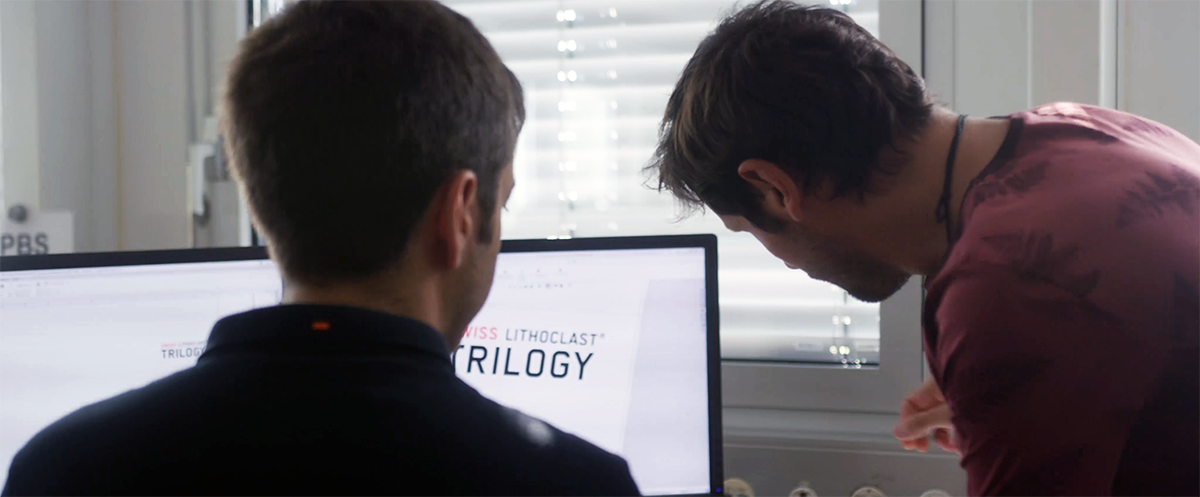
That's why we will continue to invest in the research and development of new and advanced technologies to provide innovative solutions that allow surgeons, near and far, worldwide, to remove their patients' stones as simply, quickly and as safely as possible.
The EMS Urology team already has some surprises in store for 2021 which they’re particularly excited to share with the world, so stay tuned!


